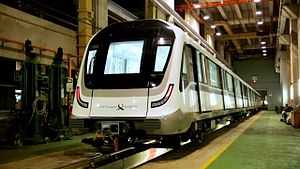Bombardier MOVIA C951
| Bombardier MOVIA C951 | |
|---|---|
 Exterior of the C951, as taken at Kim Chuan Depot. | |
 Interior view of the C951. | |
| In service | 22 December 2013–current |
| Manufacturer | Bombardier Transportation |
| Built at | Changchun, China (By Changchun Railway Vehicles) |
| Family name | Movia |
| Entered service | 2013– |
| Number under construction | 231 vehicles (77 sets) |
| Number built | 33 vehicles (11 sets) |
| Formation | 3 per trainset |
| Operator | SBS Transit DTL |
| Depot(s) | Gali Batu and Kim Chuan |
| Line(s) served | Downtown Line |
| Specifications | |
| Car body construction | High capacity aluminium |
| Train length | 70.1 m |
| Car length | 23.37 m |
| Width | 3.2 m |
| Height | 3.68 m |
| Maximum speed |
90km/h (Design) 80km/h (Service) |
| Weight | 38.3 t per car |
| Traction system |
IGBT–VVVF (Bombardier MITRAC) |
| Acceleration | 1.1 m/s2 |
| Deceleration |
1.1 m/s2 (Normal Braking) 1.4 m/s2 (Emergency Braking) |
| Electric system(s) | 750 V DC |
| Current collection method | Third rail |
| Track gauge | 1,435 mm (4 ft 8 1⁄2 in) standard gauge |
The Bombardier MOVIA C951 is a type of train built by Bombardier Transportation for use on the Downtown Line, Singapore, which is presently being built.
History

73 trainsets consisting of 3 cars each were purchased at a cost of approximately S$570.7 million for passenger service.[1] Bombardier beat Alstom, Kawasaki Heavy Industries and Hyundai Rotem in the tendering process as the lowest cost offered.[2] An addition of 15 more trains was bought by Land Transport Authority which totalled up the number of trains to 88.[3] A partial number of the total fleet operates on the Stage 1 of Downtown Line since 22 December 2013.
Delivery
These trains are under the process of delivery till 2016. They will be stabled at Gali Batu Depot and also on Kim Chuan Depot.
On 12 October 2012, the first of 11 trains for the Downtown Line Stage 1 arrived at Jurong Port and transported to Kim Chuan Depot to undergo testing by LTA before it is handed over to SBS Transit.[4]
As of 28 February 2013, Bombardier has delivered five of the 11 trains for Downtown Line Stage 1.[ 1] LTA together with the operator, SBS Transit conducted the necessary tests to ensure safety standards, functional performance and systems compatibility requirements are met before revenue service of the DTL1 which began on 22 December 2013.[5]
Operation
The C951 trains are fully automated, without attendant, running on a system similar to that used on the C751A and C830.
Features
Design
The C951 trains may include several features that were not seen in existing trains.[6]
New features include:
- an ergonomic seat profile;
- red reserved seats, which allows for clearer separation between normal and reserved seats;
- perch seats, replacing the two-seaters at the ends of the car;
- hand grips utilising joints instead of straps, providing commuters a steadier grip;
The train will also retain existing features like having two rows of poles and hand grips, and vertical poles which split into three at the center.
Dynamic Route Map Display (DRMD)
The Dynamic Route Map Display (DRMD) is a rail travel information system, newly introduced and developed for the C951 trains. The dynamic route map display panels provide commuters with their journey status updates and route information. It also indicates which side the doors will open on.[7]
Platform Gap Width Reduction (PGWR)
The train doors have a frangible gap made of rubber that protrudes out. The platform-train gap will then be reduced from 75 to 40 mm, preventing passenger accidents due to the platform gap.[7]
Others
The train will have regenerative braking which is usable over a larger range of speeds. This will generate electricity when the train slows, feeding it back to the rail network.

Serial number
Each cars are indicated with a five-digit serial number by the rail operator, SBS Transit which is similar to the Alstom Metropolis C751A trains. The car numbers of the trains range from 9001x to 9088x, where x depends on the carriage type.
- The 1st digit indicated as a "9" that refers to the train contract number, Contract C951.
- The 2nd digit must be a "0".
- The 3rd and 4th digit identifies the set number (E.g. 01).
- The final number is the car number, depending on position of the train.
An example for a C951 trainset running on the Downtown Line could be, Set 901 (also known as Set 9001). It will be consists of cars, 90011, 90012 and 90013.
See also
External links
References
- ↑ Bombardier Receives Contract from Land Transport Authority of Singapore for 219 Driverless Metro Cars Valued at Approximately 298 Million Euros
- ↑ Downtown train deal goes to Bombardier, Christopher Tan, The Straits Times, 8 November 2008
- ↑ "Shorter Waiting Time With 15 More Trains For Downtown Line". Land Transport Authority. March 28, 2013. Retrieved March 28, 2013.
- ↑ "First Downtown Line train lands in Singapore". Land Transport Authority. Retrieved November 16, 2013.
- ↑ "Land Transport Masterplan: Downtown Line Stage 1 to open on Dec 22". The Straits Times. Retrieved 16 November 2013.
- ↑ Arrival Of Downtown Line Train Mock-Up
- ↑ 7.0 7.1 "Bombardier MOVIA C951". SGTrains.
| Wikimedia Commons has media related to Bombardier MOVIA C951. |
| ||||||||||||||||||||||||||||||||||||||||

